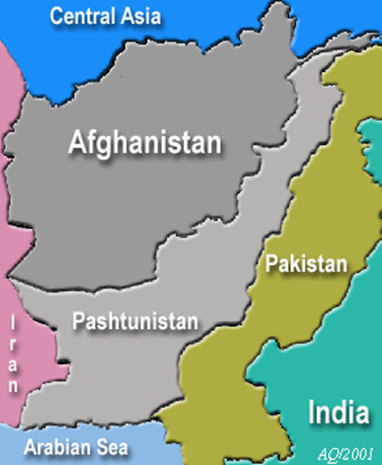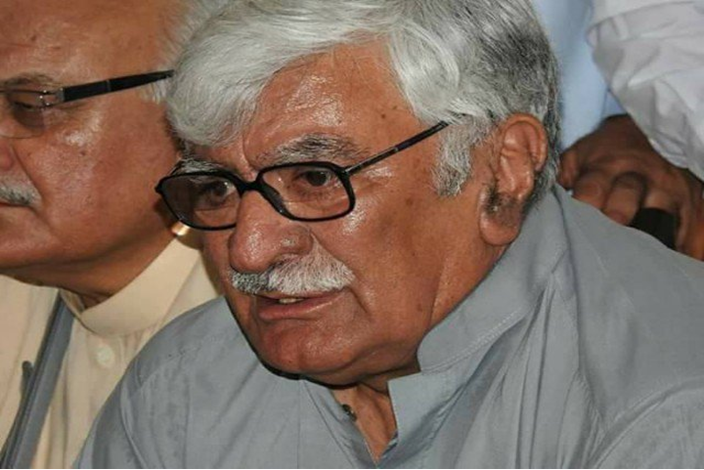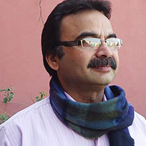


Source:
http://www.afghan-web.com/geography/greater.html
By Mohammad Zafar

PHOTO: EXPRESS
QUETTA: Awami National Party (ANP) chief Asfandyar Wali on Friday pledged to reunite all Pashtun
territories into a single unit, making it a single province.
“First of all, we will seek immediate merger of Fata with the Khyber-Pakhtunkhwa and later on merge
the annexed territories of Afghanistan, now the administrative part of Balochistan in the north,
creating a stronger and powerful province.” He said while addressing a big public meeting.
He publicly and categorically declared that he was an Afghan, he is an Afghan and he will remain an
Afghan and opined that regional peace and security depends on the situation in Afghanistan.
The ANP president pointed out to his political adversaries that brought national identity and many
more benefits for the province while concluding an alliance with the PPP and its leader Asif Ali Zardari.
What have they brought while allying themselves with Nawaz Sharif and his Muslim League Govern-
ment,” he posed a question.
Regarding peace and security in Afghanistan, Wali said: “China should stop playing the role of a
facilitator and play the real role of a guarantor of peace in the region.”
The ANP claimed that more Pakhtuns have lost their lives than the combined deaths in World War II.
“Pakhtuns are passing their lives under the shadow of war and bloodshed.”
He said Nawaz Sharif met his destiny by discriminating Pakhtuns in the CPEC scheme. “After the first
briefing, a question was raised: was it China-Punjab corridor or China-Pakistan corridor?”
He claimed that Sharif made a commitment with him and later on backed out. “Now, he has booked
his place in prison,” the ANP president predicted, referring to his past deal with a dictator that afforded
him exile in Jeddah.
He reminded Prime Minister Shahid Khaqan Abbasi that Nawaz Sharif and his government was publicly
committed to merging Fata with the K-P and later on he backed out.
He declared that all major political parties of the country were demanding immediate merger of Fata
with K-P, leaving aside the PML-N and its two Pakhtun allies.
He said “With the merger of Pakhtun areas of Balochistan in K-P, the monopoly of Punjab will be challenged.”
Without naming Maulana Fazlur Rehman, he said he is claiming that the merger of Fata is an American
agenda and thus he was terming us ‘American agents’.
He reminded the Maulana that it was the decision of the federal cabinet which is not being implemented.
Source: tribune.com.pk | Published: October 28, 2017

Tahir Mehdi
THE government of Khyber Pakhtunkhwa notified the creation of a new district in August this year. The
new district, Kolai Palas, was a sub-division of Kohistan that is one of the less populated districts of
the province.
Kohistan district has one seat in the National Assembly and three in the provincial legislature. The
mountainous area is one of the most conservative pockets of the country that regularly reports extremely
low turnouts and zero participation of women in the public and political spheres.
Kolai Palas has one seat in the KP Assembly (PK 62 Kohistan 2). Owing to its small population and low
turnout, the successful candidate, who belonged to the JUI-F, polled just 3,590 votes in elections 2013.
Why then has this small area been upgraded to an independent sub-provincial administrative unit? The
question becomes more perplexing considering that many other areas of the same province with similar
geographic and demographic features remain at the level of union councils.
New administrative units are created on the pretext of ‘popular demand’.
The answer can only be found in politics — ethnic, clan and party politics. The JUI-F MPA elected from
Kolai Palas joined the PTI in March this year and resigned from his seat as a result. Then a local jirga
decided in favour of another PTI leader, Zargul Khan, who got elected unopposed the next month on
the promise of getting the area upgraded to a district.
Four months into office, he turned the local dream into a reality. Zargul now plans to contest the
national Kohistan seat in the next general elections. He can bank on his highly obliged voters from
Kolai Palas to win the bigger seat that currently is with the PML-N. A new unit means new government
jobs and bestowing these on a section of the population is a sure way of cementing one’s political power.
Zargul is also the PTI head for Hazara region that includes Kolai Palas. The region is the only stronghold
of the PML-N that is the PTI’s rival in KP. Four of the seven national and nine of the 20 provincial seats
of the region are with the PML-N.
Zargul is not a local of Kolai Palas but from the neighbouring Torghar district where his brother Zaringul
Khan is a JUI-F MPA. Torghar too has a very small population deserving just 0.6 of a seat.
The Gul brothers are a wealthy family. Zargul has successfully combined his political ambitions with local
demands and party expediencies and made the right move at the right time to consolidate his power.
That’s how a new district is born.
But it’s not always the ambitious individuals that lead the process, as ethno-linguistic interests with wider
cross-party appeal can also drive such moves.
Take the example of Tank tehsil of Dera Ismail Khan district. When Tank was upgraded to a district in 1992,
its population was just a quarter of D.I. Khan district. Paharpur tehsil of the same district also had almost
the same population but 80 per cent of its inhabitants were Seraiki while Pakhtuns had the same percentage
in Tank. The Pakhtuns thus were given a clear advantage over Seraikis.
D.I. Khan had one seat in the National Assembly. As the total number of seats was raised in 2002, the old
district of Dera qualified for two seats. But Tank had already been carved out of it and automatically became
the candidate for the second seat. However, Tank’s population fell way short of the benchmark for a national
seat; the district was thus combined with select adjacent areas of Dera to create the new constituency which
has a majority of Pashto speakers.
Pakhtuns were 29pc of the old district of Dera Ismail Khan while Seraiki speakers were 66pc but thanks to
Tank tehsil becoming a district, only one of the two national seats of the area now has a Seraiki majority.
In other words, had Tank not been declared a district, it was likely that both Dera seats would have had a
Seraiki majority.
The decimation of Dera district along ethno-linguistic lines continued later. The creation of two new tehsils,
Darabin and Paroa, reduced the population of old Kulachi tehsil from 159,000 to just 67,000 (1998 census)
but it is now a Pashto-majority tehsil with a claim to a separate seat in the provincial assembly.
It is evident that certain Pakhtun political interests have been at work to extract maximum representation
from Dera where they were a minority and their not-so-secret route to that goal has been the creation of
new administrative units.
The phenomenon is not limited to KP. The story of the formation of Sherani district in Balochistan, Hafizabad
in Punjab and a number of new districts and talukas in Sindh over the past decade or so is no different.
The new administrative units are created on the pretext of ‘popular demand’ but certainly not all such
demands are met. Another argument is that the smaller units are good as they make governance structures
more accessible to people. But the counter-argument is that if going small is the way forward, why do it
selectively? The administration of Gujranwala district has to deal with the constituents of 23 parliamentarians
(seven MNAs and 14 MPAs) while that of Hafizabad is responsible for just that of five. So why not divide
Gujranwala further into four or five districts to offer its inhabitants the same access that people of Hafizabad
have?
More importantly, there is a whole local government system to meet the same objective; why not make it
more effective and efficient instead of taking a parallel route and that too in a clandestine, almost conspira-
torial manner?
As the limits of electoral constituencies are dictated by the administrative boundaries, the arbitrary creation
of new administrative units causes substantial distortions on the political representation map. This translates
into voters in some areas getting higher weightage in our electoral system than others.
At core is the fact that while there are rules for delimiting electoral constituencies, there exist none for creating
new administrative units. The former have to go through a process of public scrutiny but the latter just requires
an executive order. This is why the creation of new units has become the favourite route to gerrymandering of
political constituencies. A solution to it must be found.
Source: Published in Dawn, November 7th, 2017
Send email to nazeerkahut@punjabics.com with questions, comment or suggestions
Punjabics is a literary, non-profit and non-Political, non-affiliated organization
Punjabics.com @ Copyright 2008 - 2018 Punjabics.Com All Rights Reserved
Website Design & SEO by Webpagetime.com